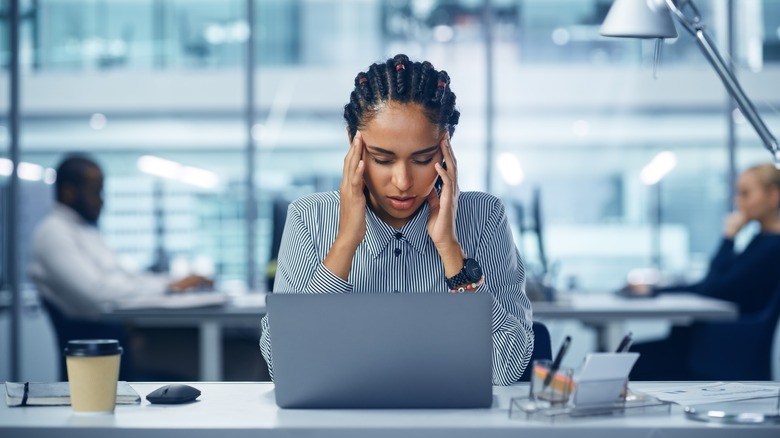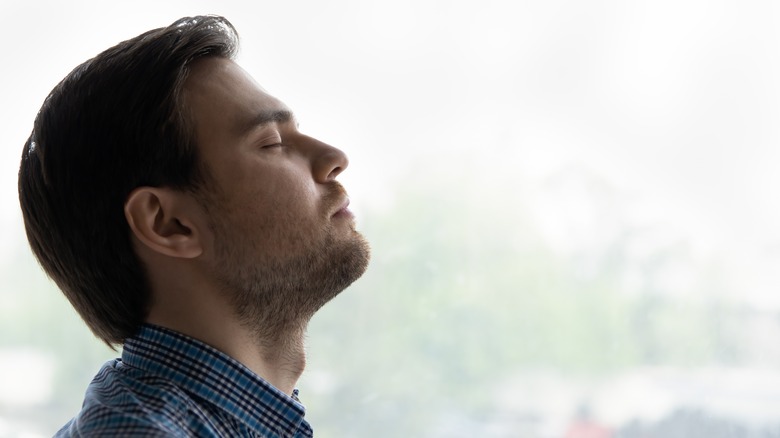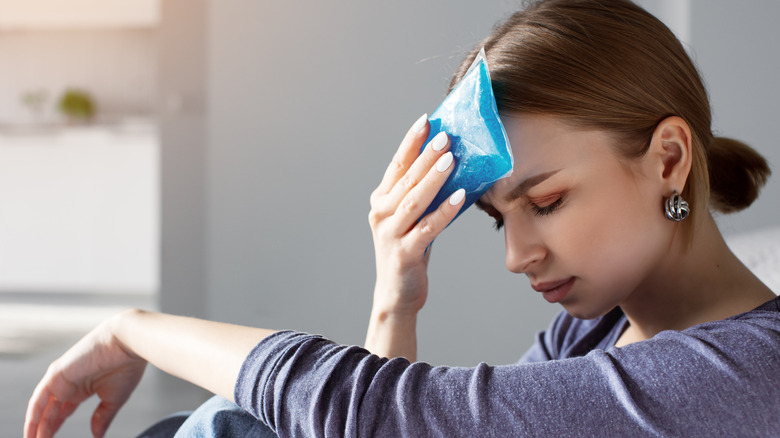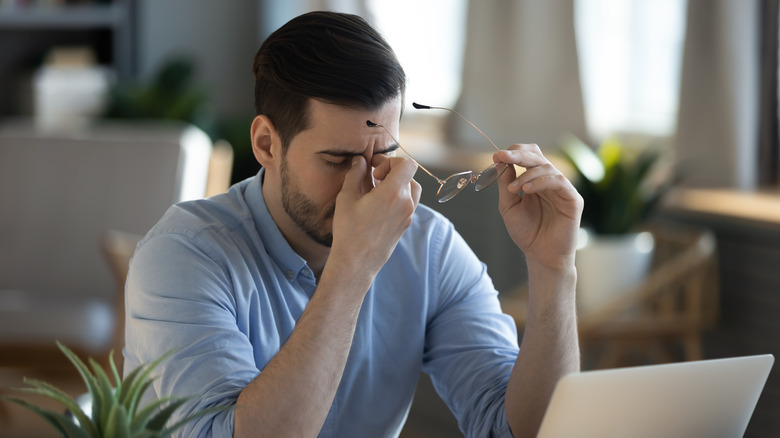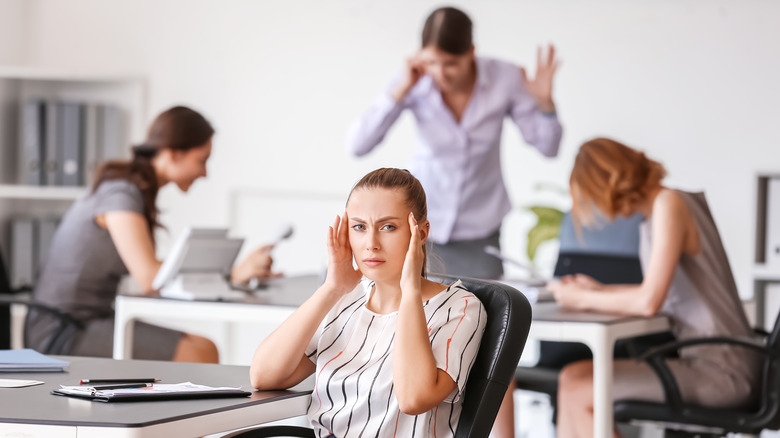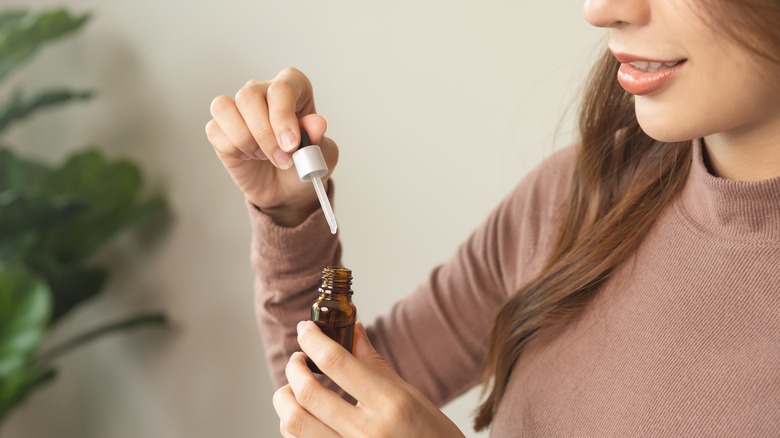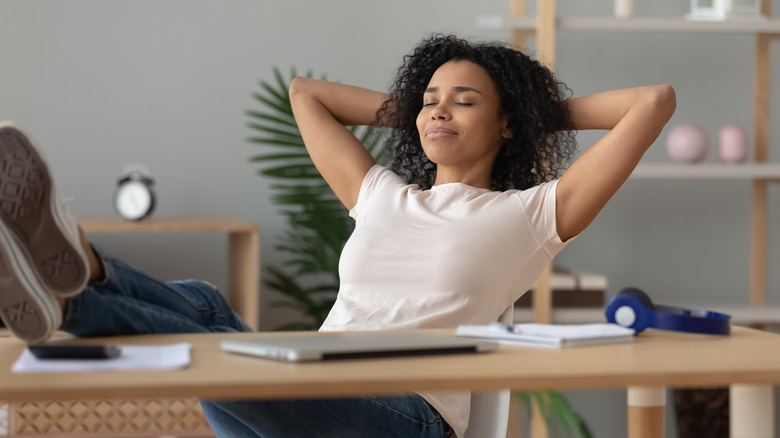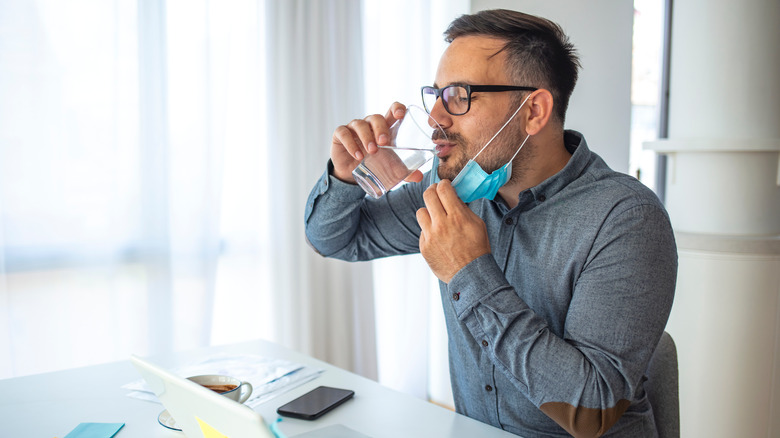Tips For Managing Migraine Attacks At Work
A migraine attack may come along with a host of undesirable symptoms such as a throbbing headache, sensitivity to light, feelings of nausea, and sometimes even dizziness and impaired vision (via The Journal of Headache and Pain). Some people experience a migraine "aura," which is a warning sign that occurs before the onset of a migraine headache (via Cureus). This usually manifests as a visual disturbance, such as a flash of light or zigzag lines, but it can also be auditory, sensory, or verbal, according to The Journal of Headache and Pain. Most migraine attacks happen without an aura, per Cureus.
Not only do migraines affect us physically, they can place a massive strain on our emotional wellbeing (via Cureus). What makes things worse is that a migraine attack can strike at any time, including at work. If you're one of the estimated 14% of people who are affected by migraines each year, you're probably familiar with how uncomfortable, and sometimes debilitating, their symptoms can be (via The Journal of Headache and Pain).
Luckily, there are numerous effective strategies that might be the answer to your migraine woes. Here are some quick and easy ways to get a pulse on your migraine headaches and prevent them from getting in the way of work.
Try breathing exercises
Breathwork can have a calming influence on the body and mind (via The Journal of Headache and Pain). It can even have a direct impact on your experience of pain, reducing and relieving the severity of your migraine headaches as well as stopping them in their tracks
Relaxation techniques like breathing exercises work their magic by decreasing sympathetic activation and central pain processing (via Journal of Neuro-Ophthalmology). There are numerous simple exercises that are easy to practice at work to prevent early migraine symptoms from escalating into a full-blown attack (via Migraine Buddy).
Deep breathing is particularly effective at keeping migraines at bay, per The Journal of Headache and Pain. If you feel a migraine coming on and notice that your breathing is fast and shallow, slow it down with calm, rhythmic breaths, recommends Migraine Buddy. Start by placing your hands on your stomach to ensure that you're breathing into your belly. Take a five-second inhalation through your nose and allow your lungs to slowly expand. Then, follow this with a five-second exhalation through your nose. Repeat this cycle for at least five minutes.
Use a cold compress on your head
Cold therapy is an age-old remedy for migraines (via Hawai'i Journal of Medicine & Public Health). It's been used for more than 150 years in a variety of ways. In fact, cold therapy is the most common self-administered treatment for migraine headaches without an aura. It involves placing an ice bag, cooling pad, or any other cold compress on your head or neck, per Migraine.com. A cold flannel or gel caps can also help. According to some research, applying a cold gel cap for 25 minutes can tame the severity of a migraine attack. In another study, migraineurs found that using a cold neck wrap for 30 minutes led to a significant reduction in migraine pain.
Cold therapy is known to have anti-inflammatory effects, according to the Hawai'i Journal of Medicine & Public Health. The cold makes your blood vessels constrict (known as vasoconstriction) and slows down blood flow, which may dull the pain of a throbbing headache. It also cools down the blood passing through your veins.
If you're using an ice pack, be sure to wrap it in cloth so as not to directly apply it to the skin, as this can cause frostbite (via Migraine.com). Always consult your doctor about whether this is safe if you're pregnant, nursing, or dealing with a health condition.
A heating pad may do the trick
While cold therapy is a popular intervention for migraine headaches, heat therapy is also known as a powerful migraine reliever (via Migraine.com). Similar to cold therapy, it involves applying something warm to the head, neck, or shoulders. This could be a hot pack, a heated pad, or a steamed towel. To use some of these methods to soothe your migraines at work, you may need access to either a kettle, stove, or microwave. If those methods aren't available at your workplace, you may want to have a plug-in heating pad handy.
Although there isn't a ton of research on the benefits of heat therapy, some people have anecdotally reported that it can help improve their migraine headaches. Sometimes cold therapy and heat therapy are used alongside one another, with the application of something hot being followed by the application of a cold compress. Heat speeds up circulation and increases blood flow, which can increase the amount of oxygen and nutrients being delivered to the region of pain. It also stimulates nerve endings, known as thermoreceptors, and in turn, dulls the pain signals to and from your brain.
Pain relief through meditation
Mindfulness meditation is another powerful tool for migraine relief. It regulates the part of your nervous system that triggers unconscious stress responses like "fight or flight," reports the American Migraine Foundation.
Meditation is the act of bringing your attention to the present moment and being aware of internal and external experiences, including thoughts and sensations. According to an article in the Journal of Neuro-Ophthalmology, studies have shown that meditation has the potential to alleviate migraine or tension-type headaches. Specifically, it can bring down the duration and intensity of pain, as well as improving your sense of self-efficacy. There are various techniques that have proven to be effective for warding off migraines, including mindfulness-based stress reduction (MBSR) and acceptance and commitment therapy (ACT). It's ultimately about finding a method that works for you.
If you're new to meditation, visualized breathing may be a good place to start (via Migraine Again). This method combines mental imagery with slow breathing. Start in a comfortable seated position with your eyes closed and bring your attention to a specific part of your body like your nostrils. With each slow inhalation, imagine the air entering your nostrils, lungs, and belly as your abdomen expands. Then imagine the air leaving your body as you exhale. You can visualize relaxation coming in and tension being released with each breath.
Self-massages can help ease pain
Not only do massages feel good, there's evidence that can help combat the agony of migraine headaches (via International Journal of Therapeutic Massage & Bodywork). Massage therapy can lower pain and feelings of distress, reduce the frequency of your headaches, and lead to higher levels of serotonin — your body's "feel-good" neurotransmitter (via the International Journal of Neuroscience). Many people find that self-massages can help tame migraine headaches, notes Migraine Again. When you apply pressure or rub specific areas of the body, you alter the messages sent between your nerves and brain. This can be soothing in moments of torment.
If you're experiencing the onset of a migraine at work, take some time out to administer a self-massage by pressing down on your temples and circling your fingers both clockwise and counterclockwise. Researchers have found that stimulating or manipulating the myofascial trigger points on the neck can also get rid of migraines (via European Journal of Translational Myology). Massage your neck and shoulder muscles in a circular motion to release the tension that builds up throughout the day, especially if you're hunched over your desk for prolonged periods of time.
Find or create a dark environment to relax in
Light is a major migraine instigator for many people (via The Journal of Headache and Pain). Up to 74% of migraineurs have light sensitivity, also known as photophobia. Exposure to flickering light can be particularly triggering. Some researchers believe that light gives rise to pain by hitting the retinal cells at the back of the eyes (via ScienceDaily). This sends pain signals to the brain via the optic nerve.
Not only can light set off your migraine, it also has the potential to make your current migraine headaches worse, notes the American Migraine Foundation. Many people find that sitting or lying down in a darkened room can help them feel better when they're in the midst of a migraine. It may even prevent a migraine attack from occurring.
If you find yourself experiencing some of the symptoms of a migraine and suspect that you may be on the verge of an attack, draw your curtains or find a dimly lit room where you can relax for a while. You could also carry an eye mask in your bag, which can help block out light — and if the mask is weighted or can also act as a cold pack, you can get dual benefits (per Manta Sleep).
Avoid noisy environments
Headaches and loud noises don't go well together. Sound hypersensitivity, also termed phonophobia, affects around 70-80% of people who suffer from migraines (via Internal Medicine). People who are vulnerable to migraine headaches tend to perceive loud noises as more intrusive and discomforting than others. Loud or prolonged sounds can also prompt and worsen a migraine headache. And unfortunately, noises like music, air conditioners, nearby traffic, or the hum of background chatter are often part and parcel of working in a busy office (per the BBC).
You can't always avoid being in a noisy place. But if you notice the symptoms of a migraine creeping up on you, it may help to find somewhere quiet to retreat to, recommends Migraine Again. If you're highly susceptible to migraines, you could speak to your employer about working in a quieter part of the office, or having a private space where you can recover if a migraine were to strike. It can also help to carry some earplugs or noise-canceling earphones in your bag.
Although cutting out noise may provide immediate relief, it could be making your phonophobia worse in the long-term, say researchers (via The Journal of Headache and Pain). Gradual exposure to noise, also termed desensitization, has been suggested as an effective long-term strategy for coping with noise triggers.
Drink or eat ginger
Ginger is celebrated for its therapeutic benefits for a number of conditions (via The Journal of Clinical Psychiatry). Many people swear by its potent anti-migraine properties. It can bring down pain and relieve both the nausea and vomiting associated with migraines. One study found that ginger could help get rid of migraine pain within just two hours of consumption (via The American Journal of Emergency Medicine). Ginger's ability to fight off migraine headaches may stem from its anti-inflammatory and analgesic properties (via Cephalalgia). It's been used to treat a variety of pain-related ailments ranging from arthritis to period pain to musculoskeletal pain. It can also settle your stomach and stave off nausea.
The spicy root plant can be consumed in a variety of ways, per Migraine.com. You can drink some ginger tea or nibble on even fresh sliced ginger if you don't mind its pungent flavor (per Healthline). Some migraineurs have found relief in powdered ginger supplements. Drinking a glass of warm water stirred with 500 to 600 mg of powdered ginger has been reported to banish headaches within half an hour, per the National Headache Foundation. In fact, 1/8 teaspoon of ginger powder might be equally as effective as the migraine medication sumatriptan, according to a study in Phytotherapy Research.
Find an essential oil that works for you
Studies on aromatherapy have shown that there are at least 10 types of essential oils that have the potential to do away with your migraine symptoms (via Journal of Ethnopharmacology). This includes lavender, which contains anti-migraine components that bring down inflammation and pain. But peppermint oil is said to be the queen of essential oils for migraines, according to a 2019 study from the International Journal of Preventive Medicine. Applying a drop of peppermint oil into the nose was found to lessen the intensity of pain in 42% of migraineurs. Its active ingredient menthol relaxes the muscles and eradicates tension. It can also work wonders on your sinuses, opening up the airways and improving respiration. Based on a 2020 study, basil oil may also offer blessed relief for people who are prone to painful migraines (via Complementary Medicine Research).
Essential oils can be used in various ways, per Migraine Strong. They usually come in concentrated form in drop bottles, and you can use them with a diffuser or added to boiling water to inhale the vapors. You can add them to your favorite carrier oil or lotion, or create a spray by adding a few drops to filtered water. You can take these with you to work as part of your emergency migraine prevention kit. Essential oils are generally safe enough to dab onto your skin — just avoid getting them into your eyes.
Try a muscle tension release exercise
When you're feeling anxious, your muscles begin to tense-up and stiffen, which can both spark and exacerbate migraine headaches (via The Journal of Headache and Pain). Using a technique that relaxes your muscles, such as a progressive muscle relaxation exercise, can relieve the pent up tension throughout your body. This helps to counter sympathetic nervous system activity, which is the part of your nervous system that kicks off the fight-or-flight response. In turn, muscle relaxation can interrupt the cycle of stress that keeps you locked in this wound-up state.
Similar to breathwork, relaxation exercises are particularly appealing for their flexibility, note researchers (via The Journal of Headache and Pain). Migraineurs should able to use these techniques in a variety of contexts and situations, such as in the workplace or even while commuting. What's more, muscle tension release is simple and straightforward to follow, per Anxiety Canada. Start by getting into a comfortable seated position and close your eyes, allowing your body to relax. Focus on a particular part of your body, such as your face or neck, and squeeze your muscles in only that area as firmly as you can for five seconds. Then release them for five seconds. Slowly move across different muscle groups throughout your body. Don't forget to take slow, deep breaths. And allow the tension to melt away.
Stay hydrated
This one may sound obvious, but people sometimes forget or fail to recognize that dehydration might be at the root of their migraine headaches, point out researchers (via Headache: The Journal of Head and Face Pain). Research shows that staying hydrated is one of the best ways to minimize the severity of a migraine headache (via Journal of Clinical Neuroscience). It can even prevent headache pain altogether. People who met the recommended daily water intake had comparatively fewer, shorter, and less intense headaches than those who did not drink enough.
In a lot of cases, a dehydration-triggered migraine can dissipate within minutes of drinking fluids, according to research (via Current Pain and Headache Reports). Though it's not always recognized by the medical community, water might just be an important piece of the puzzle. For this reason, you may want to have a full water bottle in your office or workspace at all times.

